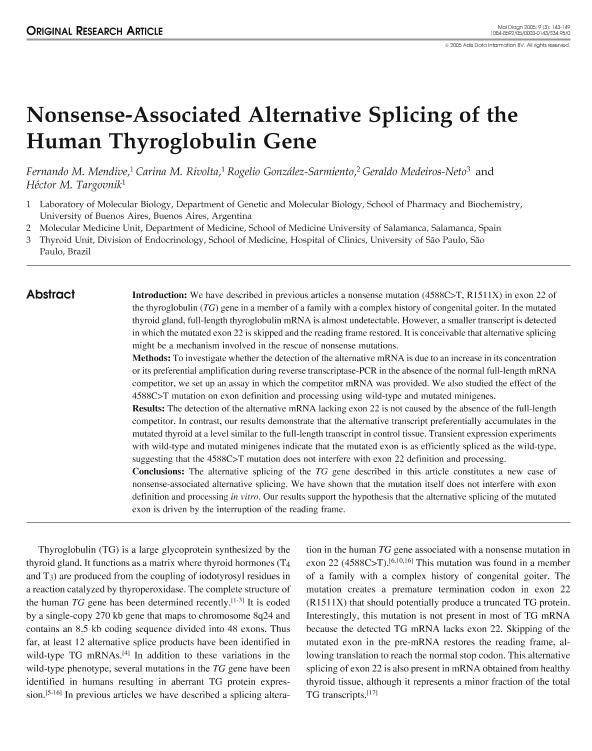Mostrar el registro sencillo del ítem
dc.contributor.author
Mendive, Fernando M.
dc.contributor.author
Rivolta, Carina Marcela

dc.contributor.author
González Sarmiento, Rogelio

dc.contributor.author
Medeiros Neto, Geraldo
dc.contributor.author
Targovnik, Hector Manuel

dc.date.available
2021-02-23T16:43:59Z
dc.date.issued
2012-12-01
dc.identifier.citation
Mendive, Fernando M.; Rivolta, Carina Marcela; González Sarmiento, Rogelio; Medeiros Neto, Geraldo; Targovnik, Hector Manuel; Nonsense-Associated Alternative Splicing of the Human Thyroglobulin Gene; Springer; Molecular Diagnosis; 9; 3; 1-12-2012; 143-149
dc.identifier.issn
1084-8592
dc.identifier.uri
http://hdl.handle.net/11336/126351
dc.description.abstract
Introduction: We have described in previous articles a nonsense mutation (4588C>T, R1511X) in exon 22 of the thyroglobulin (TG) gene in a member of a family with a complex history of congenital goiter. In the mutated thyroid gland, full-length thyroglobulin mRNA is almost undetectable. However, a smaller transcript is detected in which the mutated exon 22 is skipped and the reading frame restored. It is conceivable that alternative splicing might be a mechanism involved in the rescue of nonsense mutations. Methods: To investigate whether the detection of the alternative mRNA is due to an increase in its concentration or its preferential amplification during reverse transcriptase-PCR in the absence of the normal full-length mRNA competitor, we set up an assay in which the competitor mRNA was provided. We also studied the effect of the 4588C>T mutation on exon definition and processing using wild-type and mutated minigenes. Results: The detection of the alternative mRNA lacking exon 22 is not caused by the absence of the full-length competitor. In contrast, our results demonstrate that the alternative transcript preferentially accumulates in the mutated thyroid at a level similar to the full-length transcript in control tissue. Transient expression experiments with wild-type and mutated minigenes indicate that the mutated exon is as efficiently spliced as the wild-type, suggesting that the 4588C>T mutation does not interfere with exon 22 definition and processing. Conclusions: The alternative splicing of the TG gene described in this article constitutes a new case of nonsense-associated alternative splicing. We have shown that the mutation itself does not interfere with exon definition and processing in vitro. Our results support the hypothesis that the alternative splicing of the mutated exon is driven by the interruption of the reading frame.
dc.format
application/pdf
dc.language.iso
eng
dc.publisher
Springer

dc.rights
info:eu-repo/semantics/openAccess
dc.rights.uri
https://creativecommons.org/licenses/by-nc/2.5/ar/
dc.subject
Sitio de empalme
dc.subject
Tejido tiroideo
dc.subject
Mutación sin sentido
dc.subject
Transcripción alternativa
dc.subject
ARNm maduro
dc.subject.classification
Genética Humana

dc.subject.classification
Medicina Básica

dc.subject.classification
CIENCIAS MÉDICAS Y DE LA SALUD

dc.title
Nonsense-Associated Alternative Splicing of the Human Thyroglobulin Gene
dc.type
info:eu-repo/semantics/article
dc.type
info:ar-repo/semantics/artículo
dc.type
info:eu-repo/semantics/publishedVersion
dc.date.updated
2020-09-25T19:08:44Z
dc.journal.volume
9
dc.journal.number
3
dc.journal.pagination
143-149
dc.journal.pais
Nueva Zelanda

dc.journal.ciudad
Auckland
dc.description.fil
Fil: Mendive, Fernando M.. Universidad de Buenos Aires. Facultad de Farmacia y Bioquímica. Departamento de Microbiología, Inmunología y Biotecnología. Cátedra de Genética y Biología Molecular; Argentina
dc.description.fil
Fil: Rivolta, Carina Marcela. Universidad de Buenos Aires. Facultad de Farmacia y Bioquímica. Departamento de Microbiología, Inmunología y Biotecnología. Cátedra de Genética y Biología Molecular; Argentina. Consejo Nacional de Investigaciones Científicas y Técnicas. Oficina de Coordinación Administrativa Houssay. Instituto de Inmunología, Genética y Metabolismo. Universidad de Buenos Aires. Facultad de Medicina. Instituto de Inmunología, Genética y Metabolismo; Argentina
dc.description.fil
Fil: González Sarmiento, Rogelio. Universidad de Salamanca; España
dc.description.fil
Fil: Medeiros Neto, Geraldo. Universidade Federal de Sao Paulo; Brasil
dc.description.fil
Fil: Targovnik, Hector Manuel. Universidad de Buenos Aires. Facultad de Farmacia y Bioquímica. Departamento de Microbiología, Inmunología y Biotecnología. Cátedra de Genética y Biología Molecular; Argentina. Consejo Nacional de Investigaciones Científicas y Técnicas. Oficina de Coordinación Administrativa Houssay. Instituto de Inmunología, Genética y Metabolismo. Universidad de Buenos Aires. Facultad de Medicina. Instituto de Inmunología, Genética y Metabolismo; Argentina
dc.journal.title
Molecular Diagnosis
dc.relation.alternativeid
info:eu-repo/semantics/altIdentifier/doi/http://dx.doi.org/10.1007/BF03260082
dc.relation.alternativeid
info:eu-repo/semantics/altIdentifier/url/https://link.springer.com/article/10.1007/BF03260082
Archivos asociados
